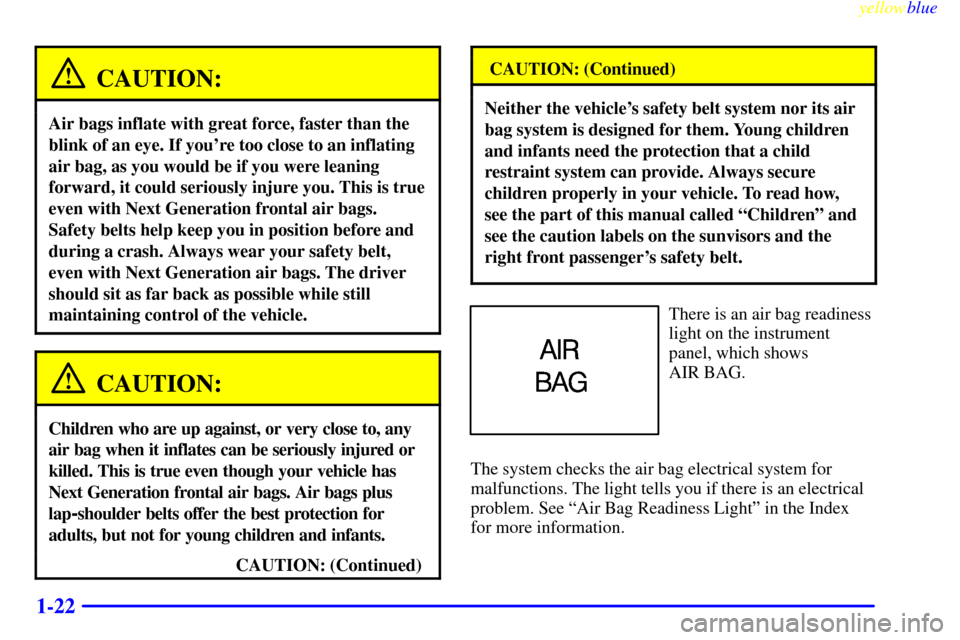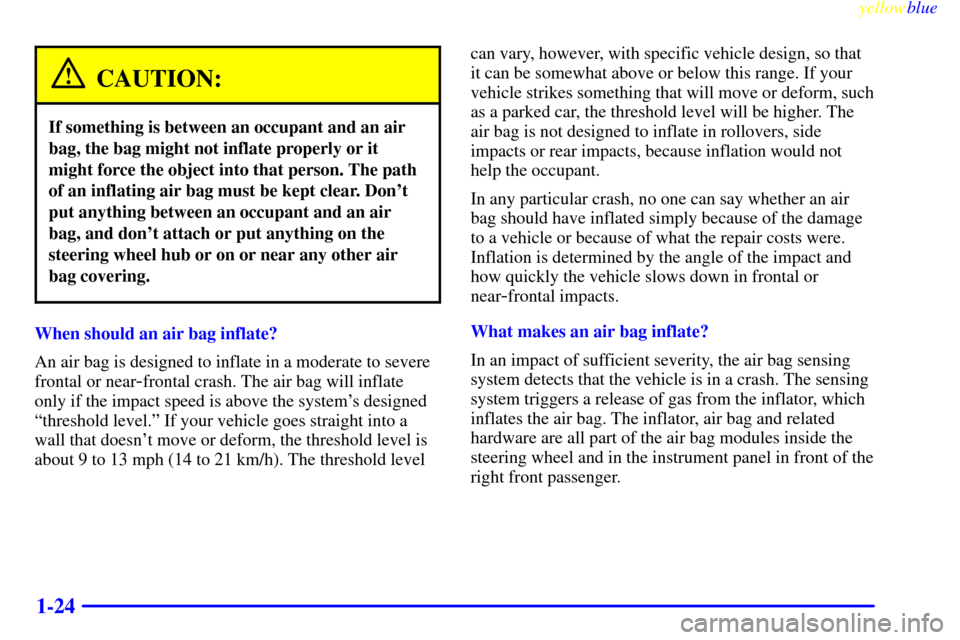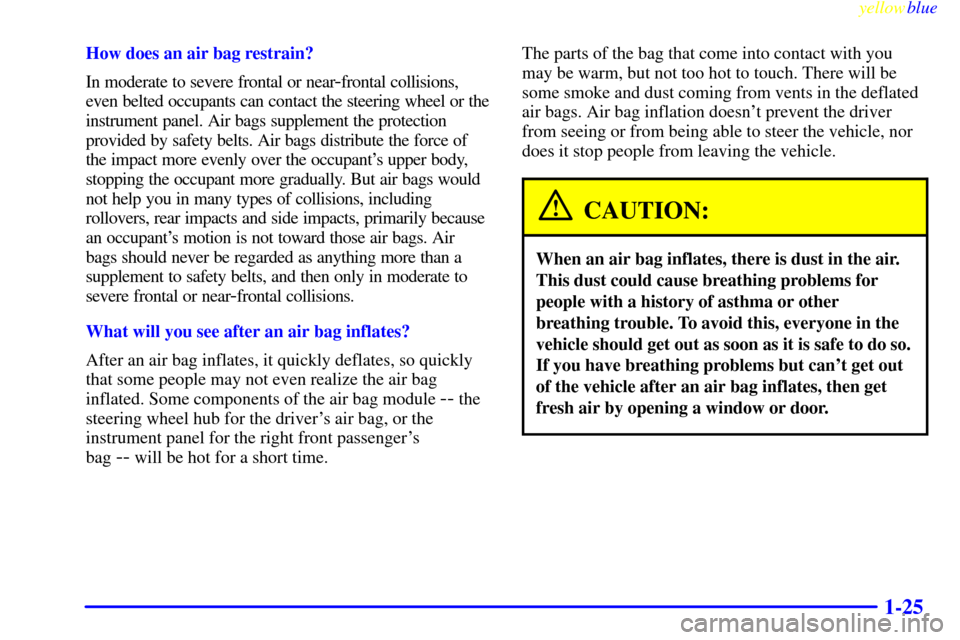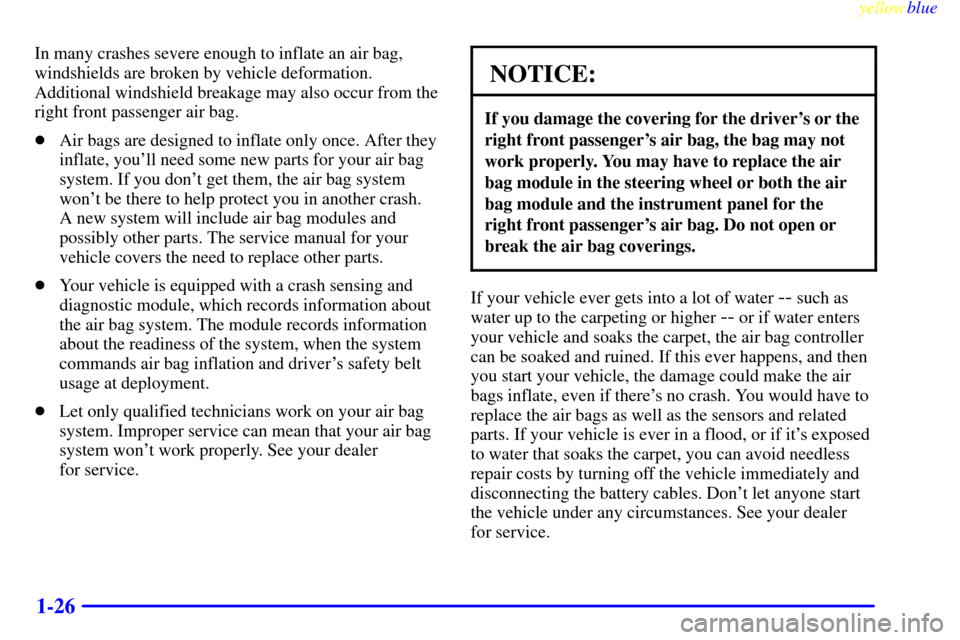Page 20 of 328
yellowblue
1-12
or the instrument panel ...or the safety belts!
With safety belts, you slow down as the vehicle does.
You get more time to stop. You stop over more distance,
and your strongest bones take the forces. That's why
safety belts make such good sense.
Page 30 of 328

yellowblue
1-22
CAUTION:
Air bags inflate with great force, faster than the
blink of an eye. If you're too close to an inflating
air bag, as you would be if you were leaning
forward, it could seriously injure you. This is true
even with Next Generation frontal air bags.
Safety belts help keep you in position before and
during a crash. Always wear your safety belt,
even with Next Generation air bags. The driver
should sit as far back as possible while still
maintaining control of the vehicle.
CAUTION:
Children who are up against, or very close to, any
air bag when it inflates can be seriously injured or
killed. This is true even though your vehicle has
Next Generation frontal air bags. Air bags plus
lap
-shoulder belts offer the best protection for
adults, but not for young children and infants.
CAUTION: (Continued)
CAUTION: (Continued)
Neither the vehicle's safety belt system nor its air
bag system is designed for them. Young children
and infants need the protection that a child
restraint system can provide. Always secure
children properly in your vehicle. To read how,
see the part of this manual called ªChildrenº and
see the caution labels on the sunvisors and the
right front passenger's safety belt.
There is an air bag readiness
light on the instrument
panel, which shows
AIR BAG.
The system checks the air bag electrical system for
malfunctions. The light tells you if there is an electrical
problem. See ªAir Bag Readiness Lightº in the Index
for more information.
Page 31 of 328
yellowblue
1-23 How the Air Bag System Works
Where are the air bags?
The driver's air bag is in the middle of the
steering wheel.
The right front passenger's air bag is in the instrument
panel on the passenger's side.
Page 32 of 328

yellowblue
1-24
CAUTION:
If something is between an occupant and an air
bag, the bag might not inflate properly or it
might force the object into that person. The path
of an inflating air bag must be kept clear. Don't
put anything between an occupant and an air
bag, and don't attach or put anything on the
steering wheel hub or on or near any other air
bag covering.
When should an air bag inflate?
An air bag is designed to inflate in a moderate to severe
frontal or near
-frontal crash. The air bag will inflate
only if the impact speed is above the system's designed
ªthreshold level.º If your vehicle goes straight into a
wall that doesn't move or deform, the threshold level is
about 9 to 13 mph (14 to 21 km/h). The threshold level can vary, however, with specific vehicle design, so that
it can be somewhat above or below this range. If your
vehicle strikes something that will move or deform, such
as a parked car, the threshold level will be higher. The
air bag is not designed to inflate in rollovers, side
impacts or rear impacts, because inflation would not
help the occupant.
In any particular crash, no one can say whether an air
bag should have inflated simply because of the damage
to a vehicle or because of what the repair costs were.
Inflation is determined by the angle of the impact and
how quickly the vehicle slows down in frontal or
near
-frontal impacts.
What makes an air bag inflate?
In an impact of sufficient severity, the air bag sensing
system detects that the vehicle is in a crash. The sensing
system triggers a release of gas from the inflator, which
inflates the air bag. The inflator, air bag and related
hardware are all part of the air bag modules inside the
steering wheel and in the instrument panel in front of the
right front passenger.
Page 33 of 328

yellowblue
1-25
How does an air bag restrain?
In moderate to severe frontal or near
-frontal collisions,
even belted occupants can contact the steering wheel or the
instrument panel. Air bags supplement the protection
provided by safety belts. Air bags distribute the force of
the impact more evenly over the occupant's upper body,
stopping the occupant more gradually. But air bags would
not help you in many types of collisions, including
rollovers, rear impacts and side impacts, primarily because
an occupant's motion is not toward those air bags. Air
bags should never be regarded as anything more than a
supplement to safety belts, and then only in moderate to
severe frontal or near
-frontal collisions.
What will you see after an air bag inflates?
After an air bag inflates, it quickly deflates, so quickly
that some people may not even realize the air bag
inflated. Some components of the air bag module
-- the
steering wheel hub for the driver's air bag, or the
instrument panel for the right front passenger's
bag
-- will be hot for a short time. The parts of the bag that come into contact with you
may be warm, but not too hot to touch. There will be
some smoke and dust coming from vents in the deflated
air bags. Air bag inflation doesn't prevent the driver
from seeing or from being able to steer the vehicle, nor
does it stop people from leaving the vehicle.
CAUTION:
When an air bag inflates, there is dust in the air.
This dust could cause breathing problems for
people with a history of asthma or other
breathing trouble. To avoid this, everyone in the
vehicle should get out as soon as it is safe to do so.
If you have breathing problems but can't get out
of the vehicle after an air bag inflates, then get
fresh air by opening a window or door.
Page 34 of 328

yellowblue
1-26
In many crashes severe enough to inflate an air bag,
windshields are broken by vehicle deformation.
Additional windshield breakage may also occur from the
right front passenger air bag.
�Air bags are designed to inflate only once. After they
inflate, you'll need some new parts for your air bag
system. If you don't get them, the air bag system
won't be there to help protect you in another crash.
A new system will include air bag modules and
possibly other parts. The service manual for your
vehicle covers the need to replace other parts.
�Your vehicle is equipped with a crash sensing and
diagnostic module, which records information about
the air bag system. The module records information
about the readiness of the system, when the system
commands air bag inflation and driver's safety belt
usage at deployment.
�Let only qualified technicians work on your air bag
system. Improper service can mean that your air bag
system won't work properly. See your dealer
for service.
NOTICE:
If you damage the covering for the driver's or the
right front passenger's air bag, the bag may not
work properly. You may have to replace the air
bag module in the steering wheel or both the air
bag module and the instrument panel for the
right front passenger's air bag. Do not open or
break the air bag coverings.
If your vehicle ever gets into a lot of water -- such as
water up to the carpeting or higher
-- or if water enters
your vehicle and soaks the carpet, the air bag controller
can be soaked and ruined. If this ever happens, and then
you start your vehicle, the damage could make the air
bags inflate, even if there's no crash. You would have to
replace the air bags as well as the sensors and related
parts. If your vehicle is ever in a flood, or if it's exposed
to water that soaks the carpet, you can avoid needless
repair costs by turning off the vehicle immediately and
disconnecting the battery cables. Don't let anyone start
the vehicle under any circumstances. See your dealer
for service.
Page 59 of 328

2-
yellowblue
2-1
Section 2 Features and Controls
Here you can learn about the many standard and optional features on your vehicle, and information on starting,
shifting and braking. Also explained are the instrument panel and the warning systems that tell you if everything is
working properly
-- and what to do if you have a problem.
2
-2 Keys
2
-4 Door Locks
2
-7 Hatchback/Trunk Lid
2
-8 Theft
2
-9 New Vehicle ªBreak-Inº
2
-10 Ignition Positions
2
-11 Starting Your Engine
2
-13 Automatic Transaxle Operation
2
-16 Manual Transaxle Operation
2
-18 Parking Brake
2
-19 Shifting Into PARK (P)
(Automatic Transaxle Only)
2
-21 Shifting Out of PARK (P)
(Automatic Transaxle Only)
2
-21 Parking Your Vehicle (Manual Transaxle
Models Only)
2
-22 Parking Over Things That Burn2
-22 Engine Exhaust
2
-23 Running Your Engine While You're Parked
(Automatic Transaxle)
2
-23 Windows
2
-24 Horn
2
-24 Turn Signal/Multifunction Lever
2
-27 Exterior Lamps
2
-28 Interior Lamps
2
-28 Mirrors
2
-29 Storage Compartments
2
-31 Ashtray and Cigarette Lighter
2
-31 Sun Visors
2
-32 The Instrument Panel -- Your
Information System
2
-34 Instrument Panel Cluster
2
-37 Warning Lights, Gages and Indicators
Page 65 of 328
yellowblue
2-7 Leaving Your Vehicle
If you are leaving the vehicle, take your key, open your
door and set the locks from the inside. Then get out and
close the door.
Hatchback/Trunk Lid
CAUTION:
It can be dangerous to drive with the hatchback
or trunk lid open because carbon monoxide (CO)
gas can come into your vehicle. You can't see or
smell CO. It can cause unconsciousness and
even death.
CAUTION: (Continued)
CAUTION: (Continued)
If you must drive with the hatchback or trunk lid
open or if electrical wiring or other cable
connections must pass through the seal between
the body and the hatchback or trunk lid:
�Make sure all other windows are shut.
�Turn the fan on your heating or cooling
system to its highest speed with the setting
on CIRCULATE. That will force outside
air into your vehicle. See ªComfort
Controlsº in the Index.
�If you have air outlets on or under the
instrument panel, open them all the way.
See ªEngine Exhaustº in the Index.